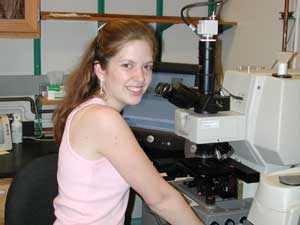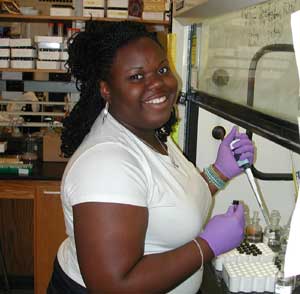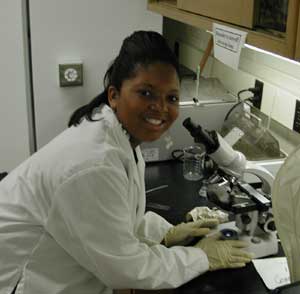Research Experiences for Undergraduates (REU) Program 2005
(Purdue University)
Genetics of carbohydrate-lignin interaction mutants in maize |
||
|
Ryan Albright - Purdue University Mentor: Wilfred Vermerris, Co-mentor: Nick Carpita |
Under the direction of Dr. Wilfred Vermerris, screening of a maize population using near infrared spectroscopy has resulted in a number of mutants in which the composition of the secondary cell wall is altered. The precise chemical changes are yet to be determined. Ryan will perform chemical analyses to determine lignin, cellulose and hemicellulose content, as well as lignin composition on a selection of these newly discovered mutants. These analyses involve wet-chemical and GC-MS analyses. In addition, he will monitor growth and development of these mutants in the field throughout the growing season. Plant samples will be collected for DNA extraction, and, time permitting, efforts to clone the mutated gene will be initiated. |
|
Characterization of members of a novel gene family associated with cellulose synthesis in Arabidopsis |
||
Using a model in vitro cell culture system, Dr. Maureen McCann has discovered several hundreds of transcripts were identified that are differentially expressed during xylogenesis. For one of these transcripts, a 30-member Arabidopsis gene family has been constructed but all members are currently annotated as genes of unknown function. Homozygous mutant lines for four of the family members show cellulose deficiency when assayed by infrared spectroscopy. Rachel will confirm the cellulose-deficient phenotype by direct chemical analyses. She will also use infrared microspectroscopy, histochemical staining, and immunogold labeling with a cellobiohydrolase-gold conjugate, to determine cell and tissue specificities. A new field-emission scanning electron microscope is the Purdue Life Science Microscopy Facility will be available for the student to obtain images of tissue architecture in each of the four mutant lines. |
||
Characterization of putative pectate lyase mutants by biochemical, spectroscopic, and microscopical analysis |
||
A small family of Arabidopsis genes are suspected of having pectate lyase activity, and T-DNA knock-outs have been prepared in the lab of Dr. Maureen McCann. ROA participant, Dr. Marta Laskowski (Oberlin College) has developed an ‘auxin-shock’ method to induce secondary roots, and has shown that one of the pectate lyase mutants has a defective cell sloughing activity related to secondary root emergence. Satoko will use infrared microspectroscopy to identify novel spectrotypes in the emerging secondary roots of the pectate lyase mutants. Her studies of this mutant and others affecting pectin structure will be coordinated with those of the REU student at University of Wisconsin. |
||
Identification of Endocytosis-related Genes and Analysis of Mutant Phenotypes |
||
Nick will clone and express as red-fluorescence protein (RFP) fusion products several genes necessary for the recovery of plasma membrane and cell wall turnover. Endocytosis is a complex process that requires several multiprotein complexes to execute plasma membrane invagination, coat formation, budding and scission in a process linked to the cortical cytoskeleton on the cytoplasmic face of the membrane. He will use several homozygous recessive mutant lines for candidate endocytotic proteins in phenotypic analysis at the whole plant level. Available to him are several full-length cDNAs for fusion with RFP. Also available are several full-length cDNAs for candidate genes, molecular biology equipment and state-of-the-art fluorescence microscopes for subcellular visualization. This project combines aspects of genetic analysis with cellular localization studies. |
||
Characterization of a putative glucomannan synthase in Arabidopsis |
||
A CslA9 mutation is the basis of rat4, a mutant that is resistant to Arabidopsis transformation (Zhu et al. 2003. Plant Physiol.133, 1000-1010), and has recently been shown to be involved in synthesis of a glucomannan. However, analysis of whole shoot or root tissue show no alterations in glucomannan content, indicating a cell or tissue specialization of expression. Indeed, the CslA9 gene is strongly expressed in newly initiated secondary roots, and the ‘auxin-shock’ method Dr. Laskowski has developed to induce overproduction of secondary roots will yield material for localized spectroscopic and biochemical studies of glucomannan synthesis defects. Rachel will employ methylation analysis by gas chromatography-mass spectrometry to characterize the linkage structure of the walls of mutant and wild type. She will also use infrared microspectroscopy to identify novel spectrotypes in the emerging secondary roots of the mutant. |
||
Characterization of pectin mutants by Fourier transform infrared spectroscopy |
||
Several mutants of Arabidopsis exist with the potential to alter pectic polysaccharides in different ways. For example, mur1, a mutation that causes a complete lack of the deoxysugar, fucose, in the cell wall, results in disruption of rhamnogalacturonan II (RG II) cross-linking and loss of tensile strength. The mur8 mutant has been characterized as a deficiency in cell wall rhamnose, but the defective gene responsible for the phenotype has not identified. A third mutant, parvus, which results in a dwarf phenotype, has been traced to defective Family 8 glycosyl transferase suspected to be involved in RG II monomer construction. Several other mutants with reduced pectin content have been identified but the genes responsible have not been characterized. Jenny will characterize and compare each of these mutants by Fourier transform infrared spectroscopy to develop ‘spectrotypes’ representative of specific ways that pectin molecules are altered. Her analyses of wall pectin composition will be made using gas-liquid chromatography-mass spectrometry will be made to establish a chemical basis for phenotype.
|
Jenny Moulton - Fort Valley State University, Georgia Mentor: Maureen McCann, Co-mentor: Nick Carpita |
|
Genetic, molecular and biochemical characterization of bk2 and bk3 |
||
The maize bk2 is a classic cell wall mutation, which is characterized by a developmentally programmed mutant phenotype in which all parts of the plant turn suddenly brittle following the 4-leaf stage. Consequently, bk2 plants snap easily, making it hard to grow them unassisted. There appears to be a link between the bk2 phenotype and cellulose deficiency, as the mutants typically have 20 to 30% less cellulose compared to their wild-type siblings. Dr. Guri Johal has cloned bk2 using a combination of transposon tagging (employing Mutator) and a candidate gene approach in which synteny between bk2 and the rice brittle culm (bc1) mutation played an important role. The bk2 gene, like its rice ortholog, encodes a protein of the COBRA family, but we still do not know what exactly is the nature of the biochemical lesion in bk2 plants and why they turn brittle around week 4 after germination. Dr. Johal has identified another brittle phenotype, called bk3, that displays the phenotype in the juvenile tissues. The defective gene has been mapped to a locus near BK2. Using molecular genetic approaches, Thomeka will attempt Mu-TAIL sequencing to identify candidate bk3 genes, as well as use biochemical approaches to identify cell wall changes that contribute to its brittle phenotype in the juvenile tissues. Using a combination of molecular and biochemical approaches, she will address whether and how the cell walls of mutants are different from their wild-type siblings and what other cell wall changes may be there that contribute to its brittle phenotype. |
||
Characterization of new mutants in a novel gene family associated with cellulose synthesis in Arabidopsis |
||
Homozygous T-DNA mutants of four members of a 30-member Arabidopsis gene family associated with cellulose synthesis have been identified and are currently under study by microspectroscopy, histochemical staining and immunogold labeling for cellulose. Libby has identified seven new members with potential T-DNA insertions in multiple alleles and will be conducing PCR to identify homozygous mutants. She will confirm the cellulose-deficient phenotype by direct chemical and immunocytochemical analyses and infrared spectroscopy. |
Libby Retsck - Purdue University Mentor: Maureen McCann, Co-mentor: Nick Carpita |
|
Biochemical aspects of the maize rust mimic (rm1) lesion mimic mutation |
||
This recessive mutation is characterized by the spontaneous formation of yellowish-brown lesions that give the illusion that the plant is infected with rust. Dr. Johal has cloned the gene underlying rm1 by tagging with Mutator: it encodes a member of the evolutionarily conserved SNAP-25 family of proteins that mediate exocytosis in trafficking pathways involving vesicles. The rm1 cells within and in the vicinity of a lesion appear to die as a result of complications arising from cellular compartmentalization and secretion. A key feature of leaf epidermal cells destined to die is the granulation of the vacuole before cell collapse. In addition, they secrete massive amounts of an amorphous material between the cell wall via vesicles. The nature of this material remains unknown, although many observations suggest it may contain callose and phenolics. In collaboration with the Carpita and McCann labs, Saundra will investigate the identity of this material. This will involve a combination of biochemical, histological, molecular infrared spectroscopic techniques. |
||
Back to top









